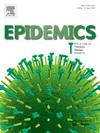Learning associations of COVID-19 hospitalizations with wastewater viral signals by Markov modulated models
IF 2.4
3区 医学
Q2 INFECTIOUS DISEASES
引用次数: 0
Abstract
Recent research highlights a strong correlation between COVID-19 hospitalizations and wastewater viral signals. Increases in wastewater viral signals may be early warnings of increases in hospital admissions. That indicates a promising opportunity to assess and predict the burden of infectious diseases and has driven the widespread adoption and development of wastewater monitoring tools by public health organizations. Previous studies utilize distributed lag models to explore associations of COVID-19 hospitalizations with lagged SARS-CoV-2 wastewater viral signals. However, the conventional distributed lag models assume the duration time of the lag to be fixed, which is not always plausible. This paper presents Markov-modulated models with distributed lasting time, treating the duration of the lag as a random variable defined by a hidden process. We evaluate exposure effects over the duration time and estimate the distribution of the lasting time using the wastewater data and COVID-19 hospitalization records from Ottawa, Canada during June 2020 to November 2022. The different COVID-19 pandemic waves are accommodated in the statistical learning. Moreover, two strategies for comparing the associations over different time intervals are exemplified using the Ottawa data. Of note, the proposed Markov modulated models, an extension of distributed lag models, are potentially applicable to many different problems where the lag time is not fixed.
利用马尔可夫调制模型学习废水病毒信号与COVID-19住院的关联
最近的研究强调,COVID-19住院与废水病毒信号之间存在很强的相关性。废水中病毒信号的增加可能是入院人数增加的早期预警。这表明有机会评估和预测传染病的负担,并促使公共卫生组织广泛采用和开发废水监测工具。以往的研究利用分布式滞后模型来探索COVID-19住院与滞后的SARS-CoV-2废水病毒信号的关系。然而,传统的分布式滞后模型假设滞后的持续时间是固定的,这并不总是可信的。本文提出了具有分布持续时间的马尔可夫调制模型,将滞后的持续时间视为一个由隐藏过程定义的随机变量。我们利用2020年6月至2022年11月期间加拿大渥太华的废水数据和COVID-19住院记录,评估了持续时间内的暴露效应,并估计了持续时间的分布。统计学习中容纳了不同的COVID-19大流行波。此外,使用渥太华数据举例说明了在不同时间间隔内比较关联的两种策略。值得注意的是,所提出的马尔可夫调制模型是分布式滞后模型的扩展,它潜在地适用于延迟时间不固定的许多不同问题。
本文章由计算机程序翻译,如有差异,请以英文原文为准。
求助全文
约1分钟内获得全文
求助全文
来源期刊

Epidemics
INFECTIOUS DISEASES-
CiteScore
6.00
自引率
7.90%
发文量
92
审稿时长
140 days
期刊介绍:
Epidemics publishes papers on infectious disease dynamics in the broadest sense. Its scope covers both within-host dynamics of infectious agents and dynamics at the population level, particularly the interaction between the two. Areas of emphasis include: spread, transmission, persistence, implications and population dynamics of infectious diseases; population and public health as well as policy aspects of control and prevention; dynamics at the individual level; interaction with the environment, ecology and evolution of infectious diseases, as well as population genetics of infectious agents.
 求助内容:
求助内容: 应助结果提醒方式:
应助结果提醒方式:


